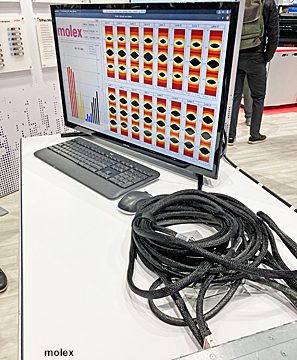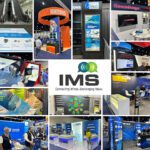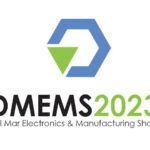Optics Outpace Copper at OFC 2024
Bob Hult shares the phenomenal advances in high-speed optical communications showcased at OFC 2024, including interconnects for 200G per lane optical transmission, liquid cooling, co-packaged optics, PAM6, and other technologies that take us far beyond the reach of copper.
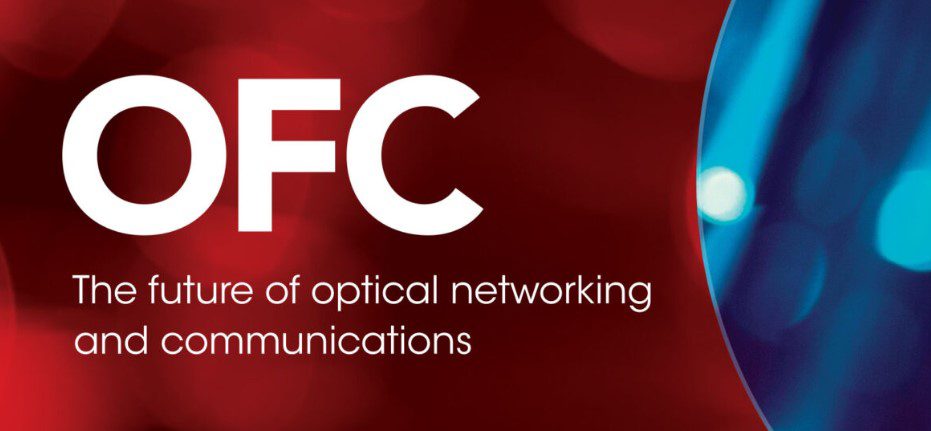
The 2024 Optical Networking and Communication Conference and Exposition March 24-April 3 in San Diego nearly filled the convention center and attracted over 13,000 participants from 74 countries. Hundreds of well-attended technical presentations showcased the latest optical and copper research and products. The schedule included a full agenda of plenary sessions, tutorials, short courses, seminars, panel discussions, workshops, and technical presentations. Topics ranged from designing sustainable electronics to the role of optics in quantum computing. Attendees had the option of participating in person or virtually. Many presentations were recorded and available for later review.
Adding 100 more exhibitors than last year, a total of 631 industry-leading manufacturers and organizations demonstrated the latest copper and optical communication technologies, including chip fabrication and test, advanced optical fiber, passive and active copper cables, optical transceivers, optical connectors, fiber management, photonic integrated circuits, and optical components.
Several broad trends were observed at OFC 24 supporting the general theme of connectivity in both copper and fiber.
- 200G, 400G, and 800G transceivers have become key enablers of next generation network equipment. The ability to support 200 Gb/s per lane transmission is the next target. Work has already begun on 400G per lane optical transmission.
- Data centers will experience exceptional growth over the next three to five years as they try to keep up with exponential increase in demand for high performance networks. Network automation and efficiency were major topics in technical presentations and on the expo floor.
- Given the increased speeds now being proposed where every tiny nuance in a connector can have a major impact on performance, copper connector manufacturers can no longer soft tool a new connector going directly to production tooling. Slight physical variations between a prototype and production connector make accurate prediction of circuit performance impossible. The commitment to introduce a new high-performance connector family has become a more expensive and riskier proposition.
- A separate market segment in support of AI computer clusters is emerging to deliver the extraordinary performance demanded by artificial intelligence, and machine learning applications. As opposed to the data center where cost remains a key factor, the top priorities in this new category at least in the short term is maximized speed, capacity, reduced power consumption and ability to quickly scale to higher performance.
- Organizations including OIF, Open AI, IEEE, and Ethernet Alliance are rapidly creating standards that will ensure interoperability of advancing optical interconnect technology. Common Management Interface Specifications (CMIS) being developed by OIF will go a long way to providing plug and play assurance in next generation devices as well as speeding deployment.
- Linear drive optics (LDO) both full and partially retimed transceivers are expected to see exceptional growth as they offer a path to lower power consumption, cost, and latency. Several exhibitors designate this technology as Low Power Optics (LPO). OEMs anticipate rapid adoption as soon as OIF releases specifications that will enable compatibility among suppliers and plug and play capability in a broad range of applications.
- The future for PCIe continues to look bright as adoption of the Gen 6.0 standard continues. Several exhibitors featured live demonstrations of equivalent performance of PCIe 7.0 which is expected to be a key in next generation AI/ML computing. Keysight demonstrated test equipment targeting PCIe 7.0 over optic applications and is preparing a pathway to 448 G optics at 180 GBd.
- Fan cooling may have reached its peak and may no longer be the best option in high-performance applications. It is unclear if cold plate or immersion cooling will become the long-term preferred solution. AI computer clusters will likely see the first major applications with new data center construction not far behind.
- Multicore optical fiber offers significant advantages of increased capacity per fiber, and reduced size and weight. HYC Co. Ltd showcased its ability to create multicore fan-out assembles using a system that optically aligns and couples to each of four cores. The data stream from each core is directed to four individual single core fibers with minimal loss and crosstalk.

Chiral Photonics is another source of multicore fanout assemblies.
- Designers of AI/ML equipment are faced with the conflicting requirements of reduced energy consumption, latency, and packaging density while increasing speed and reach. The construction of networks of networks increases system
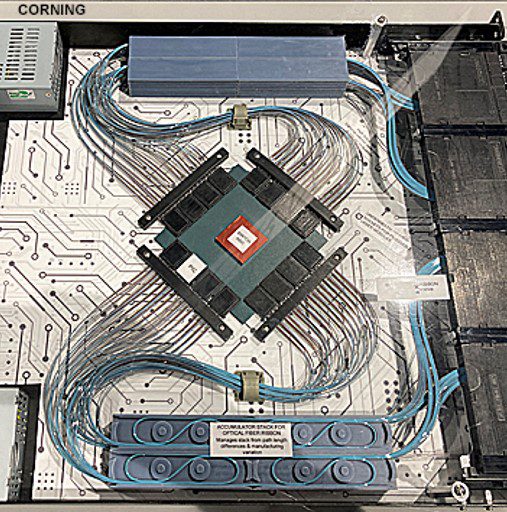 complexity, making overall reliability a challenge.
complexity, making overall reliability a challenge. - PAM4 modulation is the gold standard in today’s systems and is likely to remain so for the foreseeable future, PAM 6 or higher may become necessary in the future. Some Expo engineers were not as quick to dismiss the possibility of higher modulation levels as they were a year ago.
- Demonstrations of co-packaged optics were featured in many booths. It appears that the external laser configuration is the current choice. An on-module laser would be feasible if liquid cooling was available. Optical chiplet engines will likely be socketed for field repair. Longer term, they may be soldered.
Although OFC is primarily an optical component and system conference, approximately 15 connector manufacturers, including Amphenol, Molex, Samtec, and TE Connectivity showcased their high-performance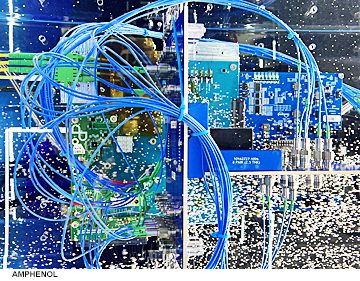 copper and fiber portfolios.
copper and fiber portfolios.
The Amphenol booth featured several new products and capabilities.
Recognizing the likely transition to liquid cooling in next-generation data centers, the EXAMAX2 ARK backplane connector has been designed to compensate for the impedance difference between air and liquid. It is rated to 112 G PAM4 and can support PCIe 6.0 and future 7.0 performance.
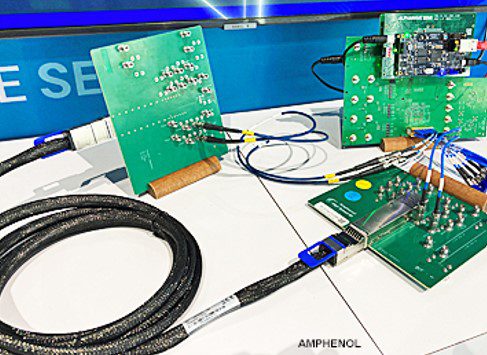
Amphenol has tooled the OSFP-XD connector and demonstrated a 3-meter cable using #32-gauge wire in a passive direct attach cable assembly. It is designed for PCIe 5/6 applications as well as 16 lanes of 100 G for 1.6 Tb Ethernet. A 200 G per lane upgrade is planned in the future.
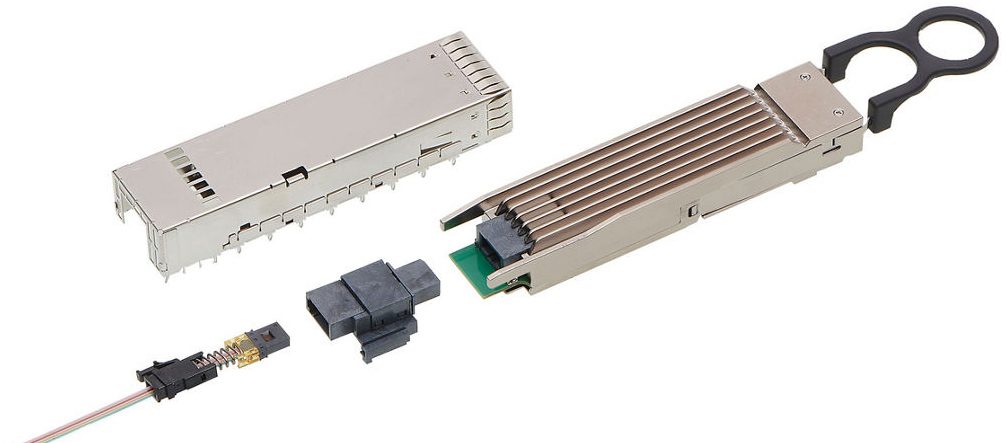
Molex showed its first to market External Laser Source Interconnect System (ELSIS), which will find applications in co-packaged optic applications.
Another live demonstration had an 800G QSFP-DD direct attach cable (DAC) and active electric cable (AEC) plugged into 25.6T switch with QSFP-DD BiPass cables inside the system. The DAC was 2m of 26AWG cable. The AEC were using two different retimer chips and had varied lengths, including 3m of 32AWG and 5m of 28AWG. Overall, BER for AEC was better than 1e-10.
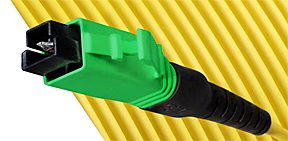
Molex also featured EBO (Expanded Beam Optical) optical cable assemblies. Rosenberger OSI and Molex are assembly solution collaborators for this unique 3M connector.
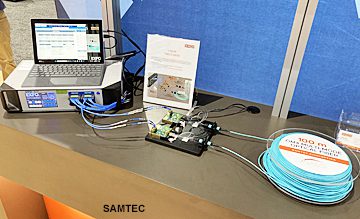
Recognizing the growing interest in linear optics, Samtec featured a live proof of concept demonstration of 112 Gb/s PAM4 over 100 meters of OM4 multimode optical fiber, using its Bullseye connectors and linear driver.
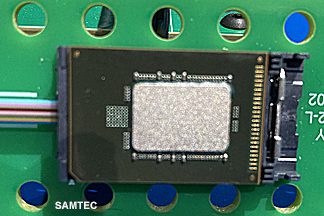
Another display featured the developmental HALO optical engine designed for next generation embedded data center applications. It will feature up to 16 channels at 112 Gb/s PAM4 and is optically pluggable to simplify field replacement. This connector is surface mounted for reliability.
The theme in the TE Connectivity booth was “High-Speed + High-Performance Solutions Empowering the AI Evolution” which captured the essence of OFC 24.
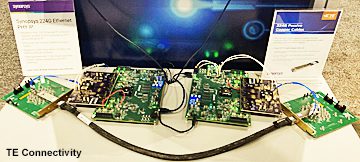
The demonstrations in the TE booth included 1 meter of passive twinaxial cable with 8 lanes at 224 Gb/s, PAM4 for a total of 1.6Tb terminated at both ends with OSFP transceivers.
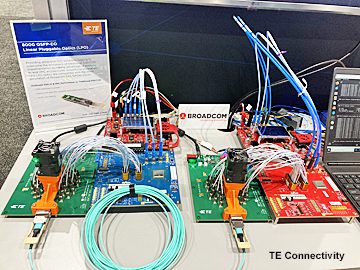
Another live display featured 800G QSFP-DD linear pluggable optics to demonstrate a 50% power reduction as well as minimizing latency, and heat using this technology
TE also showed 112G OSFP connectors directly terminated to twinaxial cable that extended internally over the surface of a PCB for near-chip and co-packaged applications.
Many domestic and offshore manufacturers promoted extensive lines of optical fiber and cable, photonic integrated circuits (PICs), coherent laser sources and materials used in the assembly of photonic devices. Dozens of QSFP, QSFP-DD, and OSFP transceiver suppliers offered every flavor of 40G, 100G, 200G, 400G, and 800G performance.
Significant advances in optical interconnects were on display from multiple suppliers.
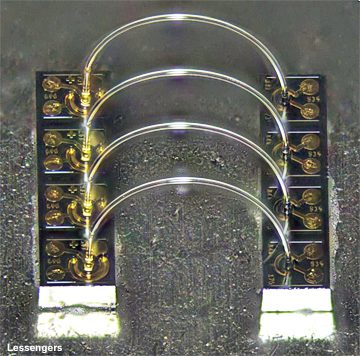
Chip-to-chip optical interconnect is an emerging technology that addresses demand for extreme system density, low power, and reduced latency. Lessengers announced a partially retimed 800G optical transceivers that uses direct optical wiring (DOW) which is a polymer-based air-cladded waveguide technology to form optical chip-to-chip interconnects.
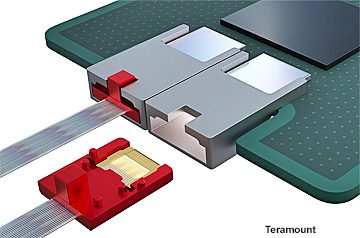
The Teramount TeraVERSE is a detachable optical fiber-to-silicon photonic chip interconnect that could find application in co-packaged optic applications.
Suppliers such as Avicena Tech are developing their Micro-LED interconnect capabilities to support next generation applications.
Concern that quantum computers will be capable of decoding any security password has been raised. Part of the Nokia booth addressed Quantum safe networking using an external key.
Once again, OFC proved to be the premier venue for advanced optical communications technology.
OFC 2025 is moving to the San Francisco Moscone Center and will be held March 30-April 3, 2025.
Like this article? Check out our other Trade Show, Innovation, and Networking articles and our 2024 Article Archives.
Subscribe to our weekly e-newsletters, follow us on LinkedIn, Twitter, and Facebook, and check out our eBook archives for more applicable, expert-informed connectivity content.
- Optics Outpace Copper at OFC 2024 - April 16, 2024
- Digital Lighting Enhances your Theatrical Experience - March 5, 2024
- DesignCon 2024 in Review - February 13, 2024
